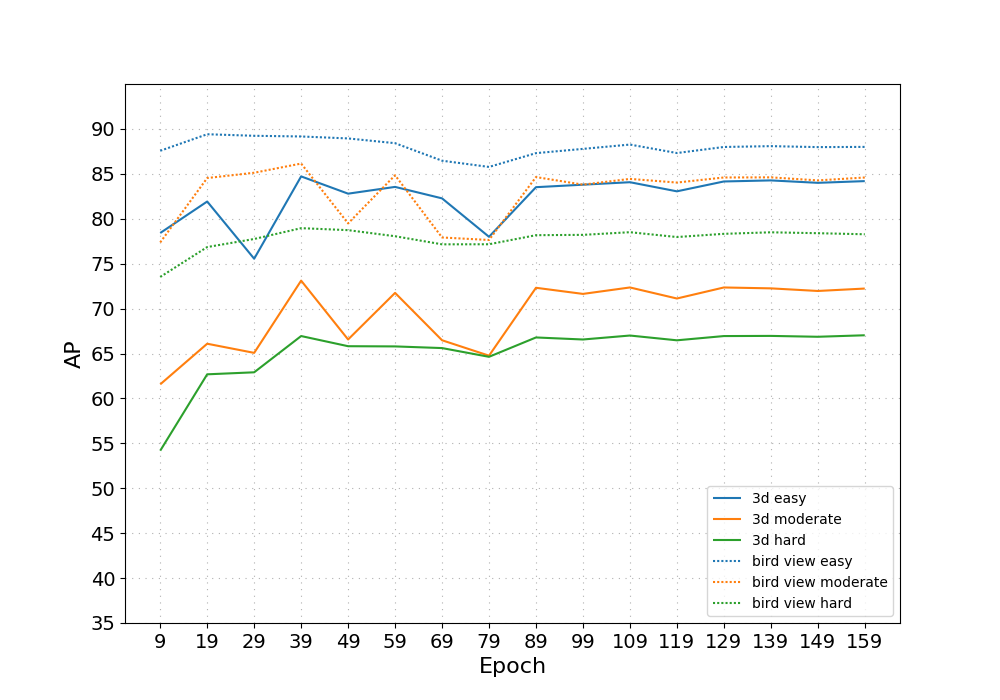This is an unofficial inplementation of VoxelNet: End-to-End Learning for Point Cloud Based 3D Object Detection in TensorFlow. A large part of this project is based on the work here. Thanks to @jeasinema. This work is a modified version with bugs fixed and better experimental settings to chase the results reported in the paper (still ongoing).
python3.5+TensorFlow(tested on 1.4.1)opencvshapelynumbaeasydict
- Clone this repository.
- Compile the Cython module
$ python3 setup.py build_ext --inplace- Compile the evaluation code
$ cd kitti_eval
$ g++ -o evaluate_object_3d_offline evaluate_object_3d_offline.cpp- grant the execution permission to evaluation script
$ cd kitti_eval
$ chmod +x launch_test.sh-
Download the 3D KITTI detection dataset from here. Data to download include:
- Velodyne point clouds (29 GB): input data to VoxelNet
- Training labels of object data set (5 MB): input label to VoxelNet
- Camera calibration matrices of object data set (16 MB): for visualization of predictions
- Left color images of object data set (12 GB): for visualization of predictions
-
In this project, we use the cropped point cloud data for training and validation. Point clouds outside the image coordinates are removed. Update the directories in
data/crop.pyand rundata/crop.pyto generate cropped data. Note that cropped point cloud data will overwrite raw point cloud data. -
Split the training set into training and validation set according to the protocol here. And rearrange the folders to have the following structure:
└── DATA_DIR
├── training <-- training data
| ├── image_2
| ├── label_2
| └── velodyne
└── validation <--- evaluation data
| ├── image_2
| ├── label_2
| └── velodyne
- Update the dataset directory in
config.pyandkitti_eval/launch_test.sh
- Specify the GPUs to use in
config.py - run
train.pywith desired hyper-parameters to start training:
$ python3 train.py --alpha 1 --beta 10Note that the hyper-parameter settings introduced in the paper are not able to produce high quality results. So, a different setting is specified here.
Training on two Nvidia 1080 Ti GPUs takes around 3 days (160 epochs as reported in the paper). During training, training statistics are recorded in log/default, which can be monitored by tensorboard. And models are saved in save_model/default. Intermediate validation results will be dumped into the folder predictions/XXX/data with XXX as the epoch number. And metrics will be calculated and saved in predictions/XXX/log. If the --vis flag is set to be True, visualizations of intermediate results will be dumped in the folder predictions/XXX/vis.
- When the training is done, executing
parse_log.pywill generate the learning curve.
$ python3 parse_log.py predictions- There is a pre-trained model for car in
save_model/pre_trained_car.
- run
test.py -n defaultto produce final predictions on the validation set after training is done. Change-nflag topre_trained_carwill start testing for the pre-trained model (only car model provided for now).
$ python3 test.pyresults will be dumped into predictions/data. Set the --vis flag to True if dumping visualizations and they will be saved into predictions/vis.
- run the following command to measure quantitative performances of predictions:
$ ./kitti_eval/evaluate_object_3d_offline [DATA_DIR]/validation/label_2 ./predictionsThe current implementation and training scheme are able to produce results in the tables below.
| Car | Easy | Moderate | Hard |
|---|---|---|---|
| Reported | 89.60 | 84.81 | 78.57 |
| Reproduced | 87.99 | 84.59 | 78.27 |
| Car | Easy | Moderate | Hard |
|---|---|---|---|
| Reported | 81.97 | 65.46 | 62.85 |
| Reproduced | 84.19 | 72.23 | 67.03 |
The learning curve (validation performances vs epoches) is presented below:
- improve the performances
- reproduce results for
PedestrianandCyclist - fix the deadlock problem in multi-thread processing in training
- fix the infinite loop problem in
test.py - replace averaged calibration matrices with correct ones
